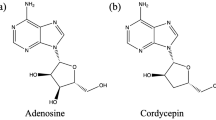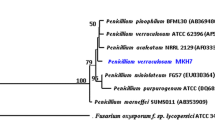Abstract
Phenazine-1-carboxamide (PCN) is one of the major biocontrol agents produced by plant growth-promoting rhizosphere (PGPR) pseudomonads including Pseudomonas chlororaphis. In this study, a combined strategy of genetic modification and statistical experimental designs was applied to obtain mutants of P. chlororaphis strains with high-yield PCN production. To achieve this, the lon gene was knocked out in wild-type P. chlororaphis HT66 and the breeding mutant P3 strain with a non-scar deletion strategy. The resulting HT66Δlon and P3Δlon mutants produced a significantly higher PCN production in shake-flask cultures which was 5- and 9-folds greater than their native counterparts. The potential ability of strain P3Δlon for PCN production was further optimized by statistical designs. A two-level Plackett–Burman (PB) experimental design with six variables was employed to scrutinize medium components that significantly influence PCN production. Notably, glycerol, tryptone, and soy peptone were identified to be the most significant factors (p < 0.05). Response surface methodology (RSM) based on the central composite design (CCD) was adopted to determine these factors optimal levels and their interactive effects between culture components for PCN production. The predicted maximum PCN production was 9002 mg/L, whereas an actual PCN production of 9174 mg/L was recorded in the validation experiments using the optimal medium containing glycerol 37.08 mL/L, tryptone 20.00 g/L, and soy peptone 25.03 g/L, which was nearly threefolds higher than without optimization and 20-folds higher than the wild-type strain. In conclusion, the results revealed that P. chlororaphis display a high potential for industrial-scale production for phenazine biopesticides.



Similar content being viewed by others
References
Asgher M, Khan SW, Bilal M (2016) Optimization of lignocellulolytic enzyme production by Pleurotus eryngii WC 888 utilizing agro-industrial residues and bio-ethanol production. Rom Biotechnol Lett 21:11133–11143
Bilal M, Guo S, Iqbal HMN, Hu H, Wang W, Zhang X (2017) Engineering Pseudomonas for phenazine biosynthesis, regulation, and biotechnological applications: a review. World J Microbiol Biotechnol 33:191
Chin-A-Woeng TFC, Bloemberg GV, van der Bij AJ, van der Drift KMGF, Schripsema J, Kroon B, Scheffer RJ, Keel C, Bakker PAHM, de Tichy HV, Bruijn FJ, Thomas-Oates JE, Lugtenberg BJJ (1998) Biocontrol by phenazine-1-carboxamide-producing Pseudomonas chlororaphis PCL1391 of tomato root rot caused by Fusarium oxysporum f. sp. radicis-lycopersici. Mol Plant Microbe Interact 11:1069–1077
Chin-A-Woeng TFC, Bloemberg GV, Mulders IHM, Dekkers LC, Lugtenberg BJJ (2000) Root colonization by phenazine-1-carboxamide-producing bacterium Pseudomonas chlororaphis PCL1391 is essential for biocontrol of tomato foot and root rot. Mol Plant Microbe Interact 13:1340–1345
Chin-A-Woeng TFC, Thomas-Oates JE, Lugtenberg BJJ, Bloemberg GV (2001) Introduction of the phzH gene of Pseudomonas chlororaphis PCL1391 extends the range of biocontrol ability of phenazine-1-carboxylic acid-producing Pseudomonas spp. strains. Mol Plant Microbe Interact 14:1006–1015
Chin-A-Woeng TFC, Van den Broek D, Lugtenberg BJ, Bloemberg GV (2005) The Pseudomonas chlororaphis PCL1391 sigma regulator psrA represses the production of the antifungal metabolite phenazine-1-carboxamide. Mol Plant Microbe Interact 18:244–253
Du X, Li Y, Zhou W, Zhou Q, Liu H, Xu Y (2013) Phenazine-1-carboxylic acid production in a chromosomally non-scar triple-deleted mutant Pseudomonas aeruginosa using statistical experimental designs to optimize yield. Appl Microbiol Biotechnol 97:7767–7778
Guo WQ, Ren NQ, Wang XJ, Xiang WS, Ding J, You Y, Liu BF (2009) Optimization of culture conditions for hydrogen production by Ethanoligenens harbinense B49 using response surface methodology. Bioresour Technol 100:1192–1196
Guo S, Wang Y, Dai B, Wang W, Hu H, Huang X, Zhang X (2017) PhzA, the shunt switch of phenazine-1,6-dicarboxylic acid biosynthesis in Pseudomonas chlororaphis HT66. Appl Microbiol Biotechnol 101:7165–7175
Hoffmann A, Thimm T, Droge M, Moore ER, Munch JC, Tebbe CC (1998) Intergeneric transfer of conjugative and mobilizable plasmids harbored by Escherichia coli in the gut of the soil microarthropod Folsomia candida (Collembola). Appl Environ Microbiol 64(7):2652–2659
Hu H, Li Y, Liu L, Zhao J, Wang W, Zhang X (2017) Production of trans-2,3-dihydro-3-hydroxyanthranilic acid by engineered Pseudomonas chlororaphis GP72. Appl Microbiol Biotechnol 101:6607–6613
Jin X, Peng H, Hu H, Huang X, Wang W, Zhang X (2016) iTRAQ-based quantitative proteomic analysis reveals potential factors associated with the enhancement of phenazine-1-carboxamide production in Pseudomonas chlororaphis P3. Sci Rep 6:27393
Kennedy M, Krouse D (1999) Strategies for improving fermentation medium performance: a review. J Ind Microbiol Biotechnol 23:456–475
Kumar R, Ayyadurai N, Pandiaraja P (2005) Characterization of antifungal metabolite produced by a new strain Pseudomonas aeruginosa PUPa3 that exhibits broad-spectrum antifungal activity and biofertilizing traits. J Appl Microbiol 98(1):145–154
Lai LST, Pan CC, Tzeng BK (2003) The influence of medium design on lovastatin production and pellet formation with a high-producing mutant of Aspergillus terreus in submerged cultures. Process Biochem 38:1317–1326
Lapouge K, Schubert M, Allain FH, Haas D (2008) Gac/Rsm signal transduction pathway of γ-proteobacteria: from RNA recognition to regulation of social behaviour. Mol Microbiol 67:241–253
Laursen JB, Nielsen J (2004) Phenazine natural products: biosynthesis, synthetic analogues, and biological activity. Chem Rev 104:1663–1685
Liu K, Hu H, Wang W, Zhang X (2016) Genetic engineering of Pseudomonas chlororaphis GP72 for the enhanced production of 2-hydroxyphenazine. Microb Cell Fact 15:131
Liu Y, Wang Z, Bilal M, Hu H, Wang W, Huang X, Peng H, Zhang X (2018) Enhanced fluorescent siderophore biosynthesis and loss of phenazine-1-carboxamide in phenotypic variant of Pseudomonas chlororaphis HT66. Front Microbiol 9:759
Mavrodi DV, Bonsall RF, Delaney SM (2001) Functional analysis of genes for biosynthesis of pyocyanin and phenazine-1-carboxamide from Pseudomonas aeruginosa PAO1. J Bacteriol 183(21):6454–6465
Myers RH, Montgomery D (2002) Response surface methodology: process and product optimization using designed experiments. Wiley, New York
Nawani NN, Kapadnis BP (2005) Novel chitinolytic bacterium isolated from a freshwater pond for shrimp optimization of chitinase production using statistics based experimental designs. Process Biochem 40:651–660
Peng H, Ouyang Y, Bilal M, Wang W, Hu H, Zhang X (2018) Identification, synthesis and regulatory function of the N-acylated homoserine lactone signals produced by Pseudomonas chlororaphis HT66. Microb Cell Fact 17:9
Pierson IIILS, Pierson EA (2010) Metabolism and function of phenazines in bacteria: impacts on the behavior of bacteria in the environment and biotechnological processes. Appl Microbiol Biotechnol 86:1659–1670
Schafer A, Tauch A, Jager W, Kalinowski J, Thierbach G, Puhler A (1994) Small mobilizable multi-purpose cloning vectors derived from the Escherichia coli plasmids pK18 and pK19: selection of defined deletions in the chromosome of Corynebacterium glutamicum. Gene 145:69–73
Shanmugaiah V, Mathivanan N, Varghese B (2010) Purification, crystal structure and antimicrobial activity of phenazine-1-carboxamide produced by a growth-promoting biocontrol bacterium, Pseudomonas aeruginosa MML2212. J Appl Microbiol 108(2):703–711
Takeuchi K, Tsuchiya W, Noda N, Suzuki R, Yamazaki T, Haas D (2014) Lon protease negatively affects GacA protein stability and expression of the Gac/Rsm signal transduction pathway in Pseudomonas protegens. Environ Microbiol 16(8):2538–2549
Tjeerd E, Wesselink M, Chin-A-Woeng TFC, Bloemberg GV, Lugtenberg BJJ (2004) Influence of environmental conditions on the production of phenazine-1-carboxamide by Pseudomonas chlororaphis PCL1391. Mol Plant Microbe Interact 17:557–566
Wang D, Lee SH, Seeve C, Yu JM, Pierson LS 3rd, Pierson EA (2013) Roles of the Gac-Rsm pathway in the regulation of phenazine biosynthesis in Pseudomonas chlororaphis 30–84. Microbiol Open 2:505–524
Warda EA, Abd El Aty AA, Hamed ER, Swelim MA, El-Diwany AI (2016) Applications of Plackett–Burman and central composite design for the optimization of novel Brevundimonas diminuta KT277492 chitinase production, investigation of its antifungal activity. Braz Arch Biol Technol 59:e16160245
Whistler CA, Stockwell VO, Loper JE (2000) Lon protease influences antibiotic production and UV tolerance of Pseudomonas fluorescens Pf-5. Appl Environ Microbiol 66:2718–2725
Zhao Q, Bilal M, Yue S, Hu H, Wang W, Zhang X (2017a) Identification of biphenyl 2,3-dioxygenase and its catabolic role for phenazine degradation in Sphingobium yanoikuyae B1. J Environ Manag 204:494–501
Zhao Q, Yue S, Bilal M, Hu H, Wang W, Zhang X (2017b) Comparative genomic analysis of 26 Sphingomonas and Sphingobium strains: dissemination of bioremediation capabilities, biodegradation potential and horizontal gene transfer. Sci Total Environ 609:1238–1247
Acknowledgements
This work was supported by the National Key Basic Research Program of China (No. 2012CB721005), the National Natural Science Foundation of China (No. 31270084), and the National High Technology Research and Development Program of China (No. 2012AA022107).
Author information
Authors and Affiliations
Corresponding author
Ethics declarations
Conflict of interest
The authors declare that they have no competing interests.
Rights and permissions
About this article
Cite this article
Peng, H., Tan, J., Bilal, M. et al. Enhanced biosynthesis of phenazine-1-carboxamide by Pseudomonas chlororaphis strains using statistical experimental designs. World J Microbiol Biotechnol 34, 129 (2018). https://doi.org/10.1007/s11274-018-2501-0
Received:
Accepted:
Published:
DOI: https://doi.org/10.1007/s11274-018-2501-0




